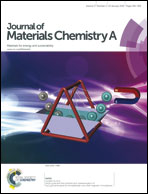Electromagnetic interference shielding through MWNT grafted Fe3O4 nanoparticles in PC/SAN blends
Abstract
In this study, multiwall carbon nanotubes (MWNTs) were chemically grafted onto dopamine anchored iron oxide (Fe3O4) nanoparticles via diazotization reaction to design electromagnetic (EM) shielding materials based on PC (polycarbonate)/SAN [poly (styrene-co-acrylonitrile)] blends. A two step mixing protocol was adopted to selectively localize the nanoparticles in a given phase of the blends. In the first step, MWNT-g-Fe3O4 nanoparticles were solution blended with PC, followed by dilution with SAN during melt mixing in the subsequent step. This strategy, besides improving the quality of dispersion of MWNTs in the blends, facilitated enhanced EM interference shielding effectiveness (SE). Both, the MWNTs and the modified MWNTs, selectively localized in the PC phase and led to high electrical conductivity, in striking contrast to PC filled MWNT composites. The SE was measured on toroidal samples over a broad range of frequencies; X-band (8.2–12 GHz) and Ku-band (12–18 GHz). It was observed that the shielding mechanism mostly involved reflection in the blends with MWNTs, whereas absorption dominated in the case of blends with MWNT-g-Fe3O4. To realize the efficacy of this strategy, a few compositions were prepared by physical mixing MWNTs with Fe3O4 nanoparticles. Intriguingly, blends with MWNT-g-Fe3O4 nanoparticles manifested enhanced microwave absorption over physically mixed nanoparticles. An SE of −32.5 dB was observed (at 18 GHz) for MWNT (3 wt%)-g-Fe3O4 (3 vol%) in PC/SAN blends.


 Please wait while we load your content...
Please wait while we load your content...